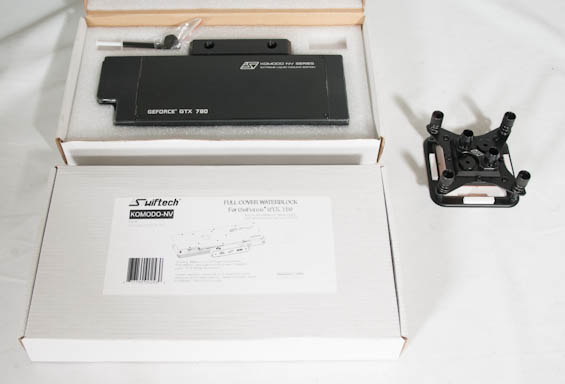The Neophyte's Custom Liquid Cooling Guide: How To, Why To, What To Expect
by Dustin Sklavos on September 30, 2013 12:01 AM ESTSo we've seen all the stuff that connects together, but fat lot of good it'll do us if we don't actually have waterblocks.

To handle our toastiest components, Swiftech sent along their Apogee HD waterblock for the Core i7-4770K and two of their KOMODO-NV waterblocks for the GeForce GTX 780s. Astute observers may find the waterblocks for the GeForces familiar. That's because Swiftech actually manufactures the waterblocks EVGA employs on their Hydro Copper cards. The Hydro Coppers are basically reference cards with faster BIOSes and Swiftech's KOMODO-NV waterblock pre-affixed. In effect, I'll be building my own pair of Hydro Coppers.
The Apogee HD comes with two barbs pre-installed, but is actually capable of supporting up to four. This allows you to run multiple components in parallel instead of a conventional serial cooling loop; since I'm intimidated enough by just trying to get the whole thing working, I stuck to just using the two. The KOMODO-NV can also be used to run multiple lines in parallel, but again I opted to run a single serial line.
Tools You'll Need
Here's information I wish I had when I started, prior to multiple runs to Orchard Supply and Home Depot, but now you'll have it. In addition to a firm grip and stellar upper body strength for affixing the compression fittings, you're going to need the following tools, bare minimum:
- Phillips head screwdrivers (one standard, one precision)
- Flathead screwdriver
- 8" adjustable wrench
- Multiple SAE wrench kit (not essential, but very helpful)
- Precision torx screwdriver kit (needed for any current generation GeForce)
The screwdriver kits I thankfully all had since almost everything we normally do when we build systems involves a screwdriver, but the wrenches I needed to get separately. These are specifically for attaching fittings and caps to ports that don't already have barbs on them (barbs being the conical ports for liquid to pass through).










106 Comments
View All Comments
bojaka - Monday, September 30, 2013 - link
And right about THERE I lost my interest in water cooling - Thanks :) I actually believed water cooling would be a viable solution to make my computer silent, but apparently not. Thanks for a great article!!utnorris - Monday, September 30, 2013 - link
You can make a near dead silent water cooled system that allows you to overclock. Unfortunately, the fans you are using in the article, while good, are not the best, regardless what marketing says. I have built probably 40 to 50 systems over the last 5 years using water cooling and noise was never an issue. If you are not overclocking then a full blown water cooling setup is not worth it, but for the added performance, it's well worth it. Also, there is no need for additives like the Hydrx, distilled water with a silver coil or some anti algae drops from your local pet store is all you need and would be less toxic. Last, as already mentioned, delidding would have seen about 10c drop on the processor and if you are going to water cool, you might as well delid your chip.Aikouka - Monday, September 30, 2013 - link
You REALLY shouldn't take a SINGLE article on water cooling as the end all, be all on whether water cooling can provide a silent build. Dustin was NOT pushing for a silent build, but rather just a build with whatever parts he was provided. I have a custom loop with an i7-4770k and two GTX 680s, and it isn't noisy at all. It is going to be a bit noisier at idle because of having significantly more fans (I have 7 120mm fans just on the radiators), but it doesn't get any noisier at load! I also use a fan controller that lets me set the fans to the speed -- and consequently, the noise level -- that I find acceptable.piroroadkill - Monday, September 30, 2013 - link
Yeah, some people think this, but since you're shifting water at the same time as pushing air, there are simply more moving parts involved. Just get a giant tower heatsink and run those fans sloooowly, and choose a GPU with a really good factory heatsink.tim851 - Monday, September 30, 2013 - link
Depends. There are much better, i.e. quieter, pumps available. The best one imo is the Aquastream by AquaComputer. Even then, a single Cpu-single Gpu system is quieter on air. A Thermalright HR-02 and an Accelero Xtreme will take care of it. Once you go SLI, however, you're running into space and heat evacuation problems. Watercooling is your only chance of acceptable noise at load now.piroroadkill - Monday, September 30, 2013 - link
Yeah, multi-GPU rigs are a different beast. At that point a custom water loop is probably your best bet.But for single CPU/single GPU rigs, water is basically a vanity project, not one that will actually give you lower noise.
piklar - Monday, September 30, 2013 - link
Great article Dustin! It just so happens I have been considering a watercooling project this summer (new Zealand time) using the Corsair Air540 with 4770K and SLI GTX 780s. Ironicly it appears The Raven RV03 is doing just as good if not better job of the cooling with Corsair H80 and reference card cooling. You have shown how luck of the draw Haswell can be since the 4770Ks Ive come across all do 4.6ghz on 2.8- 3.0v no probs. Still your article was very useful and much appreciated.Death666Angel - Monday, September 30, 2013 - link
2.8V to 3.0V? That's not right. :PRazorbak86 - Monday, September 30, 2013 - link
LOL. My thought exactly. I'm sure he meant 1.28-1.30V. ;-Ppiklar - Monday, September 30, 2013 - link
soz was half asleep, thanks for clarifying that I meant meant 1.280 - 1.30V for 4.6ghz with 4770K with H80.